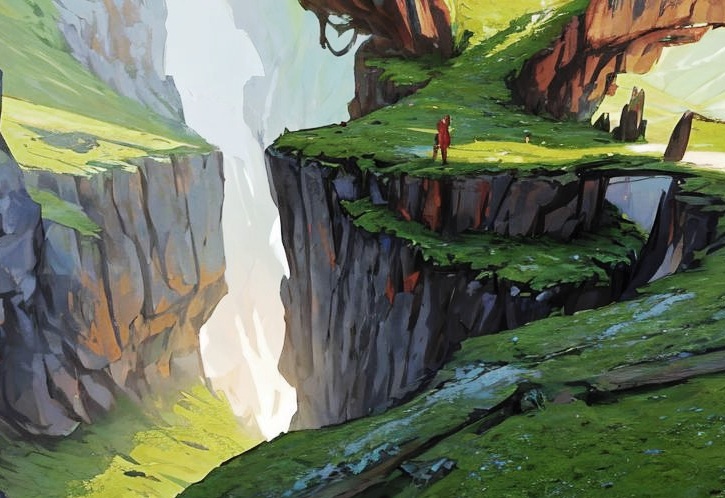Chasm
Chasms are deep and elongated clefts or cracks in the terrain. They are formidable geographical features often encountered in various settings, particularly in alpine, desert, taiga, woodland and subterranean ranges. Varying in width, chasms may be a few feet across or several hundred feet wide; they are usually wider than a typical step or leap.
Chasms are deep, with depths ranging from a few feet to hundreds of feet, or sometimes even deeper, adding an element of uncertainty and danger. The sides are typically composed of sheer cliffs or jagged rocks, making them difficult to climb and often devoid of vegetation or soil. Crossing a chasm usually requires specialized equipment, such as ropes, grappling hooks or constructed bridges, though adventurers may need to find alternate routes or use magical means to traverse the gap. The bottom of a chasm is often shrouded in darkness, concealing what lies below and adding tension and mystery. These features can occur in environments ranging from deep underground caves to open landscapes, diversifying the challenges adventurers face.
In the context of a campaign, chasms are not just physical obstacles but also key narrative and strategic elements. They can serve as natural barriers, hiding places or sites of significant encounters. A chasm might guard the entrance to a dungeon, conceal a hidden treasure hoard or act as a dividing line between opposing factions. These features provide opportunities for creative problem-solving and exploration while reinforcing the theme and atmosphere of a region.
Chasms often influence the local setting. Settlements near them may depend on bridges or ropeways to connect communities, with these structures becoming potential points of conflict or targets for enemies. Local folklore may include tales of creatures or treasures lurking within the depths, drawing adventurers into perilous quests. A chasm's sheer scale and isolation can make it a place of awe or dread, amplifying its impact in the story.
As dynamic terrain, chasms introduce a variety of risks and opportunities. Unstable ledges, falling rocks or hidden predators can turn a seemingly simple crossing into a deadly challenge. Adversaries may use chasms tactically, setting traps or using the environment to their advantage in combat. These elements make chasms ideal for scenarios that test perception, agility and creativity.
For campaigns involving planar travel or mythological elements, chasms can take on even greater significance. They might conceal rifts to other planes, such as the Abyss, or lead to forgotten underworlds. A seemingly mundane chasm might become the focal point of a grander mystery or confrontation, making it a crucial part of the campaign's progression.
Chasms also act as a crucible for party dynamics. Successfully navigating these features often demands teamwork, strategic planning and the effective use of each character's unique abilities. The risk of failure, whether through injury, separation or death, adds weight to the challenge and makes triumph all the more rewarding.
